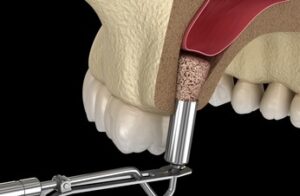Sinus Lifting (Augmentation)
This is the key to implant success is the quantity and quality of the bone where the implant is to be placed. The upper back jaw has traditionally been one of the most difficult areas to successfully place dental implants due to insufficient bone quantity and quality and the close proximity to the sinus. If you’ve lost bone in that area due to reasons such as periodontal disease, diabetic or tooth loss, you may be left without enough bone to place implants.
 Sinus lift surgery – also known as sinus augmentation – can help correct this problem by raising the sinus floor and developing bone for the placement of dental implants. Several techniques can be used to raise the sinus and allow for new bone to form.
Sinus lift surgery – also known as sinus augmentation – can help correct this problem by raising the sinus floor and developing bone for the placement of dental implants. Several techniques can be used to raise the sinus and allow for new bone to form.
In one common technique, an incision is made in the gum to expose the bone. Then a small circle is cut into the bone. This bony piece is lifted into the sinus cavity, much like a trap door, and the space underneath is filled with bone graft material. Your periodontist can explain your options for bone graft materials, which can regenerate lost bone and tissue.
Bone Grafting
Over a period of time, the jawbone associated with missing teeth atrophies or is reabsorbed. This often leaves a condition in which there is poor quality and quantity of bone suitable for placement of dental implants. In these situations, most patients are not candidates for placement of dental implants.
Today, we have the ability to grow bone where needed. Bone grafting can repair dental implant sites with inadequate bone structure due to previous extractions, gum disease or injuries. This not only gives us the opportunity to place implants of proper length and width, it also gives us a chance to restore functionality and esthetic appearance.
Recovery from Sinus Lifting
Following either procedure, patients may experience swelling in the area or bleed from their nose or mouth. It is critical to avoid forcefully sneezing or blowing one’s nose in the immediate aftermath of sinus lift surgery. Either action could cause the grafted bone material to shift or loosen the stitches. While there may be some discomfort following the procedure, it is typically minimal. We can provide pain medicine to relieve any discomfort. Additionally, we may prescribe:
- Antibiotics and an antimicrobial mouthwash should be applied to prevent infections
- Anti-inflammatory medication should be taken to reduce swelling
- Decongestants or saline spray to keep a patient’s nose clear and moist
Furthermore, we will provide detailed instructions for proper post-surgical care and schedule follow-up appointments to ensure the sinus lift procedure was a success. Careful monitoring is critical to guaranteeing a strong upper jawbone that can support dental implants.
Tooth Extraction and Bone Graft Cost
The cost of socket preservation grafting can vary depending on the amount of bone grafting material required and the type of graft chosen. The overall cost usually ranges between $250 and $350.
Sinus Lifting Surgery Cost
Sinus liftin surgery cost between $450 and $800 and this surgery patient should wait for 6 – 7 months before dental implant surgery.

